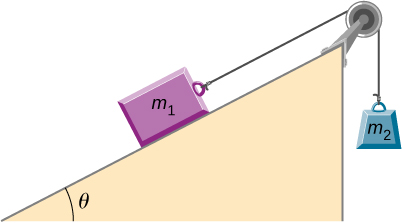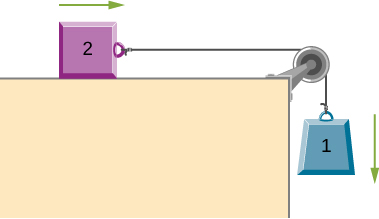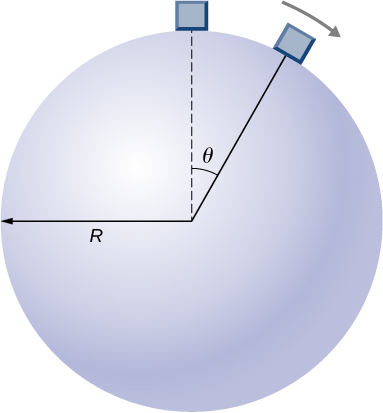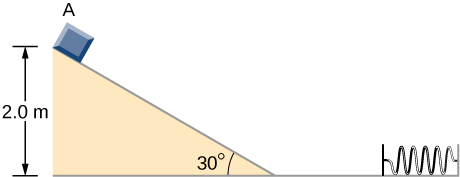| << Chapter < Page | Chapter >> Page > |
A T-shirt cannon launches a shirt at 5.00 m/s from a platform height of 3.00 m from ground level. How fast will the shirt be traveling if it is caught by someone whose hands are (a) 1.00 m from ground level? (b) 4.00 m from ground level? Neglect air drag.
A child (32 kg) jumps up and down on a trampoline. The trampoline exerts a spring restoring force on the child with a constant of 5000 N/m. At the highest point of the bounce, the child is 1.0 m above the level surface of the trampoline. What is the compression distance of the trampoline? Neglect the bending of the legs or any transfer of energy of the child into the trampoline while jumping.
42 cm
Shown below is a box of mass that sits on a frictionless incline at an angle above the horizontal . This box is connected by a relatively massless string, over a frictionless pulley, and finally connected to a box at rest over the ledge, labeled . If and are a height h above the ground and : (a) What is the initial gravitational potential energy of the system? (b) What is the final kinetic energy of the system?

A massless spring with force constant hangs from the ceiling. A 2.0-kg block is attached to the free end of the spring and released. If the block falls 17 cm before starting back upwards, how much work is done by friction during its descent?
0.44 J
A particle of mass 2.0 kg moves under the influence of the force Suppose a frictional force also acts on the particle. If the particle’s speed when it starts at is 0.0 m/s and when it arrives at is 9.0 m/s, how much work is done on it by the frictional force between and
Block 2 shown below slides along a frictionless table as block 1 falls. Both blocks are attached by a frictionless pulley. Find the speed of the blocks after they have each moved 2.0 m. Assume that they start at rest and that the pulley has negligible mass. Use and

3.6 m/s
A body of mass m and negligible size starts from rest and slides down the surface of a frictionless solid sphere of radius R . (See below.) Prove that the body leaves the sphere when

A mysterious force acts on all particles along a particular line and always points towards a particular point P on the line. The magnitude of the force on a particle increases as the cube of the distance from that point; that is , if the distance from P to the position of the particle is r . Let b be the proportionality constant, and write the magnitude of the force as . Find the potential energy of a particle subjected to this force when the particle is at a distance D from P , assuming the potential energy to be zero when the particle is at P .
An object of mass 10 kg is released at point A , slides to the bottom of the incline, then collides with a horizontal massless spring, compressing it a maximum distance of 0.75 m. (See below.) The spring constant is 500 M/m, the height of the incline is 2.0 m, and the horizontal surface is frictionless. (a) What is the speed of the object at the bottom of the incline? (b) What is the work of friction on the object while it is on the incline? (c) The spring recoils and sends the object back toward the incline. What is the speed of the object when it reaches the base of the incline? (d) What vertical distance does it move back up the incline?


Notification Switch
Would you like to follow the 'University physics volume 1' conversation and receive update notifications?